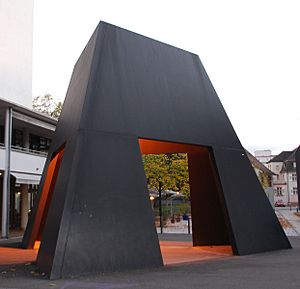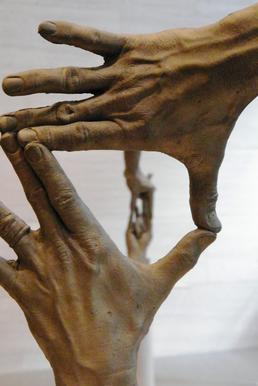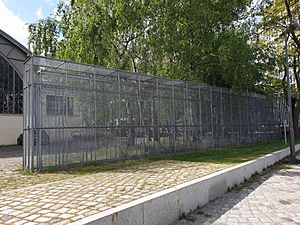Bruce Nauman facts for kids
Quick facts for kids
Bruce Nauman
|
|
|---|---|

Truncated Pyramid Room (1982/1998) in Lörrach, Germany
|
|
| Born | December 6, 1941 Fort Wayne, Indiana, US
|
| Education | University of Wisconsin–Madison and University of California, Davis |
| Known for | sculpture, photography, neon, video, drawing, printmaking and performance |
|
Notable work
|
La air, 1970, Human/Need/Desire, 1983 |
| Awards | Larry Aldrich Award, Golden Lion at 53rd Venice Biennale |
Bruce Nauman (born December 6, 1941) is an American artist famous for his creative and thought-provoking art. He doesn't stick to just one style. Instead, he makes sculpture, photography, art with neon lights, videos, drawings, and even performances.
Contents
Who is Bruce Nauman?
Bruce Nauman was born in Fort Wayne, Indiana. His father was an engineer, so his family moved around a lot when he was young. At first, Nauman studied math and physics in college. But he soon switched to art, graduating in 1966.
After college, Nauman had a big idea in his studio. He thought, "If I'm an artist in my studio, then whatever I do here must be art." This changed how he saw his work. For him, art became more about the act of creating and less about just making a finished object to sell.
He started making videos where he used his own body to explore ideas. For example, he would perform simple actions in front of a camera, like pacing around a square on the floor. This was a new way of thinking about what art could be.
Playing with Words and Ideas
Nauman loves to play with language. He often uses words in his art to make people think. He creates visual puns, which are like jokes you can see. For example, one of his neon signs says Run From Fear – Fun From Rear.
He is also interested in how we communicate and the problems that can happen with language. He was inspired by the philosopher Ludwig Wittgenstein, who studied how we use words.
Different Kinds of Art
Nauman is known for using many different materials and styles.
- Neon Signs: He often uses bright neon tubes to write phrases or create images. The glowing lights make you think about advertisements, but he uses them to share deeper ideas.
- Corridors and Rooms: In the late 1960s, he began building narrow and enclosed corridors that people could walk into. These installations could make visitors feel surprised or thoughtful as they moved through the space.
- Sculpture and Video: In the 1980s, he started making sculptures and videos that explored challenging feelings and situations. He often used models of animals or human body parts in his work.
Famous Artworks

Bruce Nauman has created many memorable pieces of art. Here are a few examples:
- Art Make-Up (1967): A video where Nauman slowly puts on different colors of makeup (white, pink, green, and black) until his face is completely covered.
- The True Artist Helps the World by Revealing Mystic Truths (1967): A neon sign that spirals into the center with this message. It makes you wonder what "mystic truths" an artist might reveal.
- Wall-Floor Positions (1969): A video where Nauman holds different poses with his body against a wall and the floor. It shows how an artist can use their own body as a tool for art.
- Henry Moore bound to fail, back view (1967–1970): A sculpture made from a cast of Nauman's own back and arms, which are tied behind him. In 2001, this work sold for over $9 million.
- Clown Torture (1987): This video installation shows clowns in different situations on four screens. One clown tells a joke, another balances a fishbowl, and another shouts. It explores feelings of humor and frustration.
- Vices and Virtues (1988): A huge neon sign at the University of California, San Diego. It flashes seven virtues (like FAITH, HOPE, CHARITY) and seven vices (like ..., ENVY, SLOTH).
- Animal Pyramid (1989): A tall pyramid made from 17 stacked animal molds, the kind used by taxidermists. It stands twelve feet high.
- Setting a Good Corner (Allegory & Metaphor) (1999): A video that shows Nauman doing a simple, practical task: building a fence corner on his ranch. It turns an everyday job into a piece of art.
- Raw Materials (2004): An art piece made only of sound. It was installed in a large hall at the Tate Modern museum in London. Visitors heard 21 different audio recordings Nauman had made over 40 years.
Awards and Recognition

Bruce Nauman is considered one of the most important artists of our time. He has won many major awards for his work.
- Wolf Prize (1993): He received this award for his amazing work as a sculptor and his impact on 20th-century art.
- Golden Lion (1999 and 2009): This is the top prize at the Venice Biennale, a famous international art exhibition. He won it twice.
- Praemium Imperiale (2004): A global arts prize awarded by the Japan Art Association.
- Time 100: In 2004, Time magazine named him one of the 100 most influential people in the world.
His art is shown in major museums all over the globe, including the Museum of Modern Art in New York, the Tate Modern in London, and the Centre Pompidou in Paris.
Who Influenced Nauman?
Nauman was inspired by many different people, including writers, musicians, and other artists. Some of his biggest influences were:
- The writer Samuel Beckett
- The philosopher Ludwig Wittgenstein
- The composer John Cage
- The artist HC Westermann
He was also part of an art movement called Process Art, where the process of making the art is just as important as the final piece.
See also
 In Spanish: Bruce Nauman para niños
In Spanish: Bruce Nauman para niños


